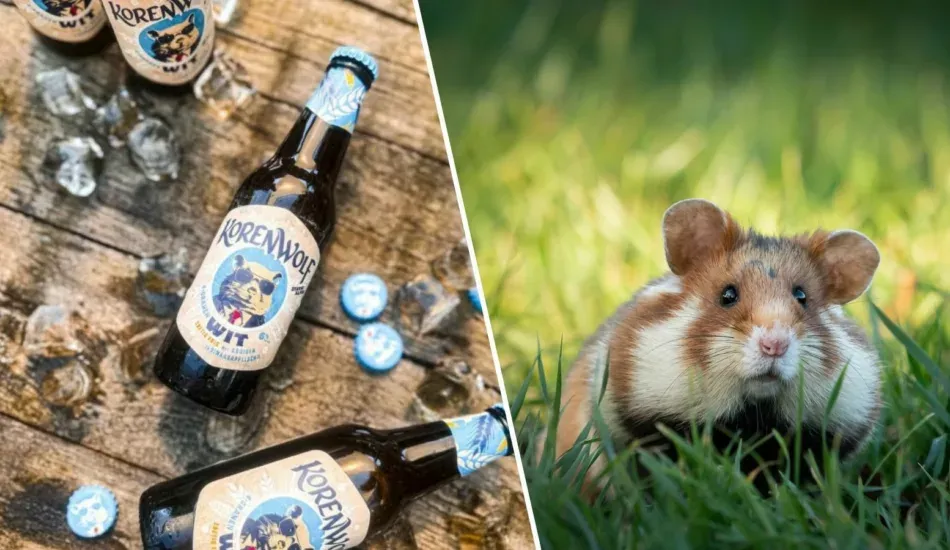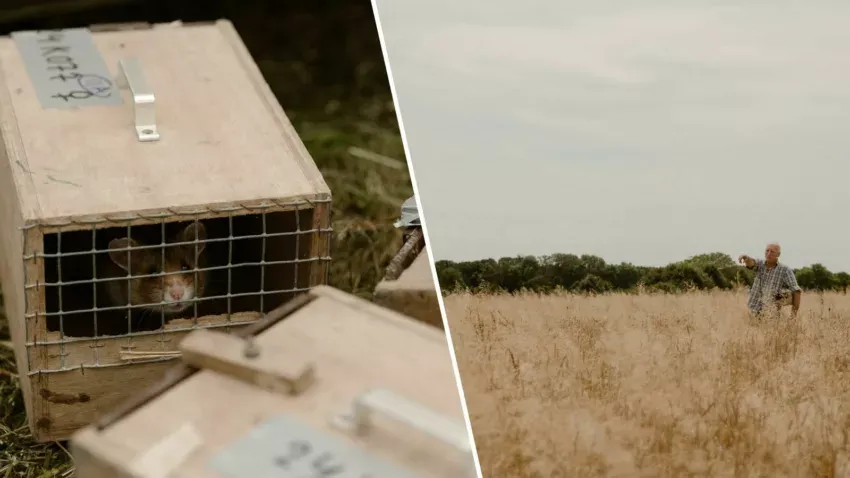At first glance, white beer and wild hamsters have nothing to do with each other, but appearances can be deceptive. With its revamped Korenwolf white beer, Gulpener is supporting the endangered hamster. From every beer sold, 1 percent will be donated to increase the population.

It is Thursday morning 06.55 when my train leaves The Hague Central Station. First in the direction of Utrecht, and then on to Kerkrade. The municipality lies in the eastern part of southern Limburg, right on the German border. It is the habitat of the hamster, although its habitat is under pressure. As a result, the little hamster is in serious trouble and is one of the country's most endangered species.
Territory
.The territory of the corn wolf is not improving. With the expansion of surrounding cities, the habitat is shrinking. And with the intensification of agriculture, fields are becoming unsuitable for the corn wolf. Monoculture farming, pesticide use and climate change are causing biodiversity to decline. Fewer insects, flowers and herbs can be found in the fields, making it harder for the corncrake to get food. Less food means fewer chances for survival. As a result, the population is declining rapidly.
Breeding programs
.To prevent the animal from becoming extinct, a breeding program has been set up from the Gaia Nature Fund. The fund is part of the GaiaZoo zoo and is financially supported by Gulpener. From every corncrake beer it sells, the brewer donates 1 percent to the fund. Emile Prins takes care of the breeding of the corn wolf and welcomes me to the zoo. A short walk takes us past Przewalski horses, tapirs and beavers. The final destination is a room where dozens of pens are arranged in equal rows. "About 150 hamsters are born at the zoo every year. In this section where visitors don't come, we raise them." The enclosure is currently empty. The breeding program runs from February to June, so it has now come to an end. "After just a few weeks, the animals can be released into the wild," he continues. "That seems fast, but corn wolves often only live to be two, sometimes three years old. So everything happens at a rapid pace. They grow up quickly, reproduce quickly and thus also die quickly."
Hamster-friendly fields
Once the hamsters are big enough, they are released into special reserves. "These we completely adapt to the hamsters. Crops are still grown on the fields, but the farmers we work with do this in a hamster-friendly way. They leave the crops longer, so there is more shelter for the hamsters. This allows them to hide in times of danger and they are less likely to fall prey to foxes and large birds."
Mixtures of herbs and flowers are sown along the fields. The strips attract insects and other soil life. That promotes biodiversity, and that means more food for the warbler. Establishing those biodiversity strips is essential, Prins says. "We can breed and release new hamsters all the time, but they have to be able to survive in the wild. The habitat must be suitable. If we do nothing about the environment, there is simply not enough food. Then what we do is nice and all, but we'll never get the population up to par."
.
Exit
One such hamster sanctuary is located about a 20-minute drive from the zoo. Dozens of hamsters have already been released on some 50 acres of land. Project coordinator Gerard Müskens has been responsible for many of those releases. It's noticeable. With a dexterity, he unloads the wooden boxes from the van in which the hamsters are hiding. Then he grabs a bucket containing straw and food: sunflower seeds and pieces of apples. "Then the hamsters will have food for the first few days at least," he explains. "After that, the idea is for them to look for food and save themselves."
On the wooden boxes is the number of the particular hamster, its weight, whether it is a male or female and the burrow number where the animal will be released. Müskens makes a walking route based on the crates. Then he takes one wooden crate and the bucket into the field. Arriving at the destination, he explains how the hamsters are released. "We put the crates vertically on a previously dug burrow. Such a burrow is two meters deep and consists of a system of corridors to different rooms. It is a safe place: when danger threatens above ground, the hamsters rush to the burrow and drop down. Below ground they are safe."
He turns the wooden box a quarter turn, sets it on the castle and slides it open at the bottom. The "ground" falls away and the hamster dives right into the castle. When it is out of sight, Müskens puts some straw on the opening. Then he scatters sunflower seeds around the spot and lays down some pieces of apple. "That's basically it," he concludes. "Now the hope is that this one survives." The same ritual repeats several times, until all the hamsters have been evicted.

Counting castles
To find out how effective these releases are and how many hamsters live in Limburg, burrows are counted in the areas where they are released. Several hamsters are also given a transmitter with which they are tracked. This keeps track of which area they are in and how old they get. This is important, Prins believes. "That way we know how the population is developing. It is estimated that there are currently several hundred corn wolves living in the Netherlands. Ultimately, we want the corn wolf to be self-sustaining and we want to be able to stop the breeding program and evictions. More numbers are needed for that: thousands rather than hundreds."
That's not on the table right now, Müskens says right away. "Were we to stop restocking corn wolves now, they would disappear within a few years." That's why he is working closely with other countries where the corn wolf occurs, such as Belgium, France and Germany. There, too, initiatives are underway to help the corn wolf. "We see what happens there and what we can learn from it. Conversely, neighboring countries are following the initiatives in Limburg with interest. It was recently discovered that food has a direct effect on the corn wolf's litter size. Normally, a female gives birth to 5 to 6 young. But a diet with more protein and healthy fatty acids allows that number to increase to 8. That's good to know. In fact, reproduction is very important to maintain the population."
Dutch Beer Challenge
In the meantime, beer brewer Gulpener continues to financially support the hamster. The more Korenwolf witbier it sells, the more money goes to the eponymous animal. Recently, the beer was revamped and the recipe changed. As a result, it won first place at the Dutch Beer Challenge. At the brewery, they hope the white beer will be enjoyed by many. Prins and Müskens concur. The more people drink it, the more donations will flow to the hamster.
Source: change.inc